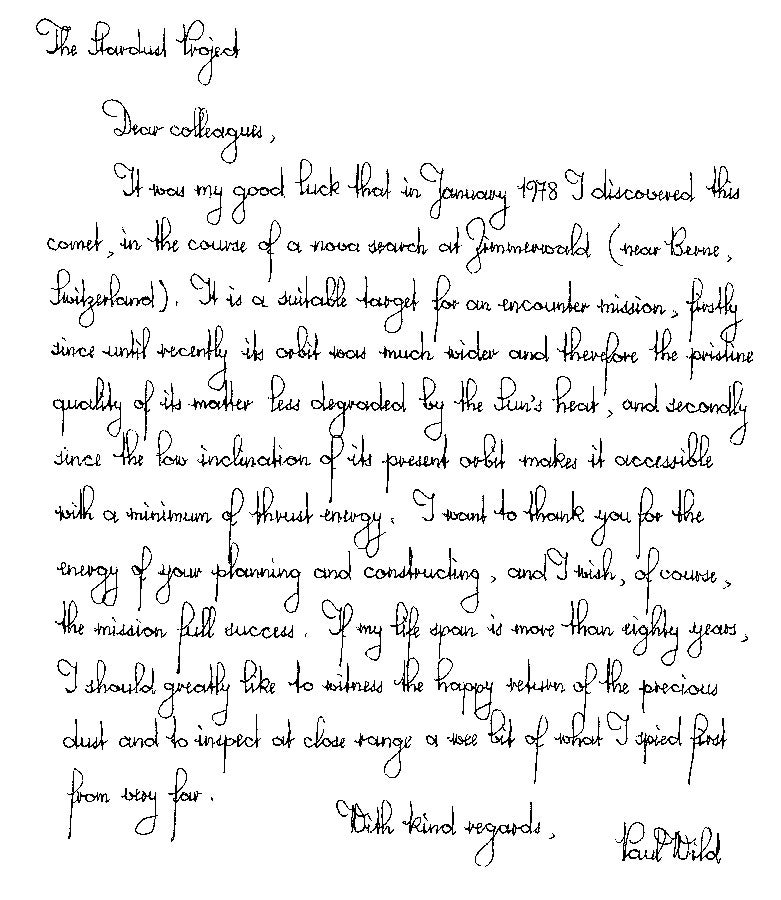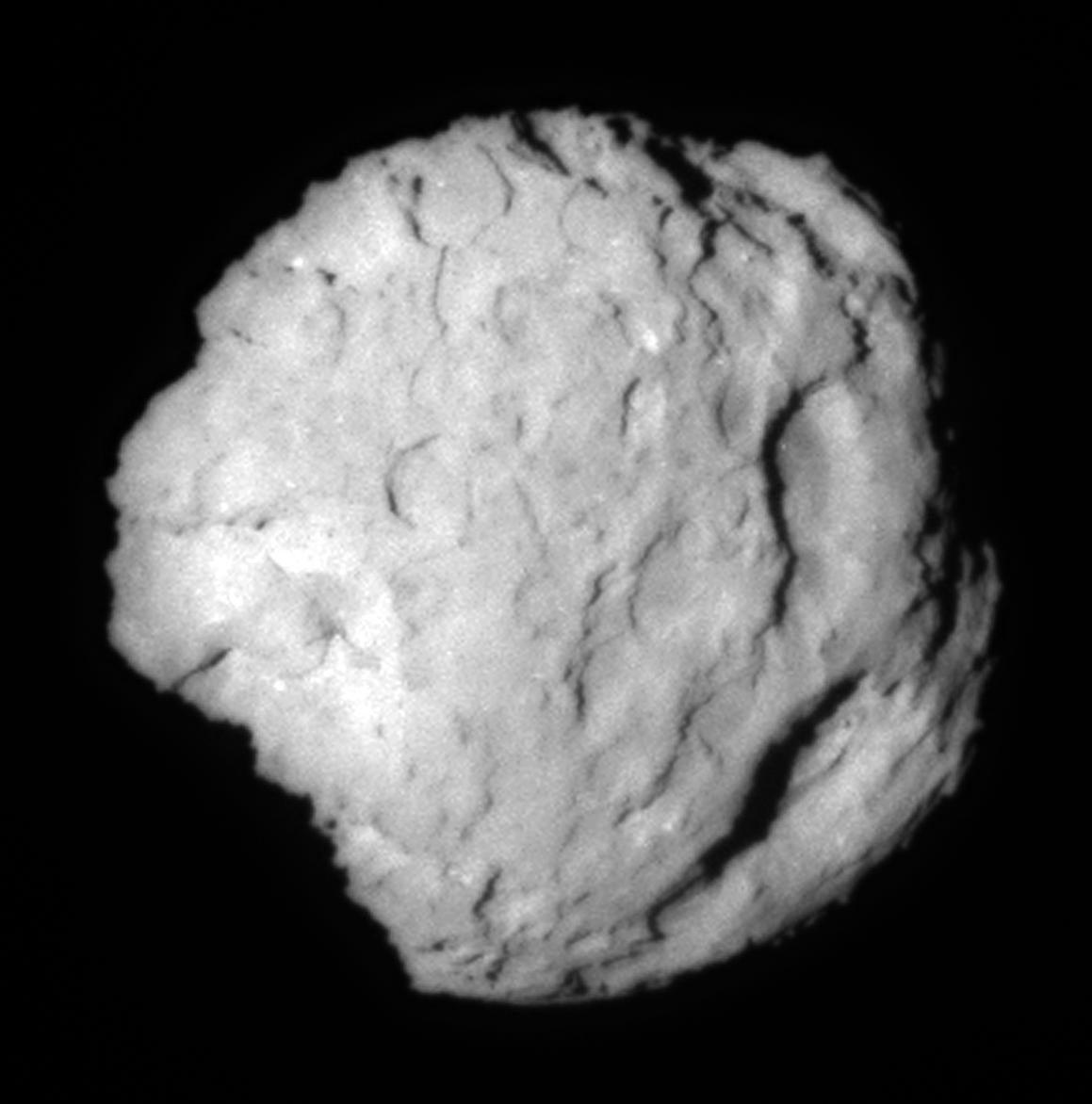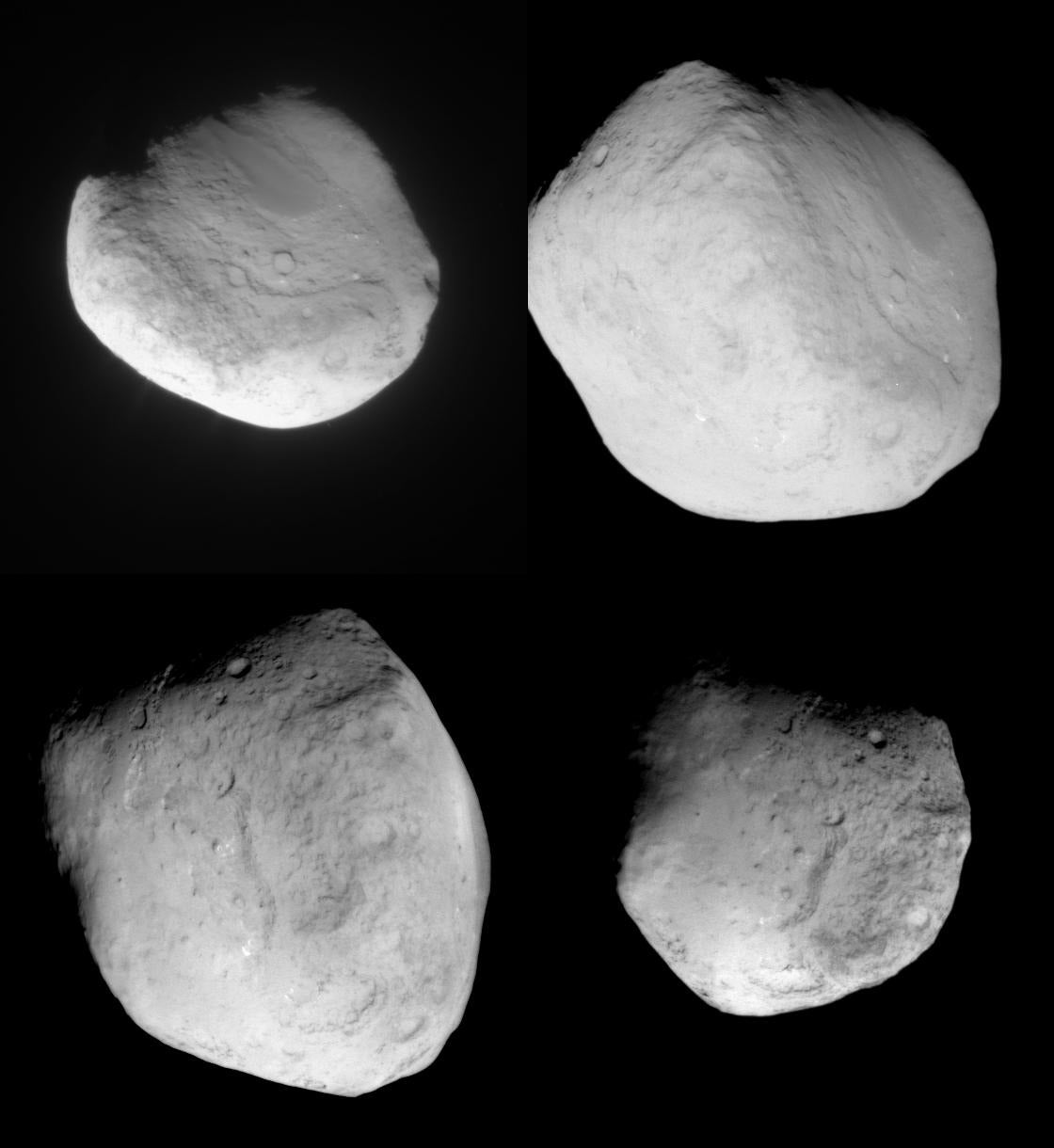
This composite image shows the three small worlds NASA Stardust spacecraft encountered during its 12 year mission. Stardust performed a flyby of asteroid Annefrank in 2002, Comet Wild in 2004, and Tempel 1 in 2011. Credit: NASA.
Amid the vibrant colors of worlds, large and small, in the Smithsonian Institution’s Kenneth C. Griffin Exploring the Planets Gallery sits Stardust, a curiosity that travelled 2.88 billion miles (4.63 billion kilometers), visited an asteroid, got sandblasted by a comet, then screamed back to Earth faster than any human-made object in history. After a blazing reentry, it landed under parachutes in Utah’s desert salt flats, turning science fiction into reality.
Eerily backlit in icy blue tones reminiscent of the frigid places it once visited, Stardust was America’s first effort to recover extraterrestrial material from beyond the Moon: over 10,000 micron-sized grains from a comet whose composition had seen scant change in 4.5 billion years. It was a beguiling reminder that science’s grandest rewards often sprout from its tiniest treasures.
“Stardust … represents a reversal in traditional exploration techniques,” said Project Manager Ken Atkins of NASA’s Jet Propulsion Laboratory (JPL) in a 1997 statement about the project. “Instead of taking expensively-packaged instruments to the target of interest, Stardust [brings] samples of the targets to laboratories on Earth.”
But this sample-return capsule, curated by the Smithsonian since 2008, is only part of the $199.6 million story. Conceived in 1980 but considered unworkable at the time, NASA green-lighted Stardust for development in 1995 as a faster, better, cheaper Discovery mission. Led by Principal Investigator Don Brownlee of the University of Washington, Stardust took aim on Wild-2 (pronounced Vilt-2), a long-period comet whose 43-year solar orbit was hewn down to six years by a close encounter with Jupiter.
Wild-2’s path changes
In September 1974, Wild-2 grazed Jupiter at less than 600,000 miles (960,000 km) and the giant planet’s gravity perturbed its orbit, thrusting it deep into the inner solar system to become a short-period comet. A circuitous path that once carried it from jovian distance almost as far as Uranus was dramatically reshaped, the comet’s aphelion shrinking to 5.3 AU and its perihelion to 1.59 AU. (One astronomical unit, or AU, is equal to the average Earth-Sun distance of 93 million miles or 150 million km.)
Wild-2 was discovered in January 1978 by Swiss astronomer Paul Wild (1925-2014). Particles of the comet would be “soft-captured” by Stardust for return to Earth: “The samples … [will be] extremely small,” explained Brownlee in a 1999 statement. “Even if a ton of sample were returned, the main information … would still be recorded at the micron level, and the analysis would still be done a single grain at a time.”
Roughly the size of an office desk, Stardust had eight hydrazine thrusters, five science instruments, and two solar arrays. Three spaced-armor composite bumpers, called Whipple Shields after U.S. astronomer Fred Whipple (1906-2004), who conceived them as a means of protecting spacecraft from micrometeoroid and other impacts, guarded Stardust against a raging hailstorm of cometary dust.
A JPL-built navigation camera would map Wild-2’s nucleus to glean clues about its origins, morphology and mineralogy. Germany’s Max-Planck Institute supplied a mass spectrometer and JPL’s dynamic science experiment measured the comet’s internal structure. The University of Chicago supplied a dust-flux monitor to track the ebb and flow of cometary material and its impact on Stardust.
And the University of Washington’s tennis-racket-sized sample collector would take specimens from Wild-2. It was filled with aerogel, an ultra-lightweight silicon dioxide foam capable of withstanding pressures thousands of times greater than its own mass. Cometary particles would bury themselves into this porous, spongelike “solid smoke,” leaving well-defined tracks for post-mission analysis.
A ‘happy return of the precious dust’
Stardust rose from Florida’s Cape Canaveral Air Force Station atop a Delta II rocket at 4:04 p.m. EST on Feb. 7, 1999. Watching the launch were Wild and Whipple. “If my life span is more than 80 years,” Wild wrote to NASA’s Stardust team, “I would greatly like to witness the happy return of the precious dust and to inspect at close range a wee bit of what I first spied from very afar.”

Stardust barreled into deep space at 70,000 mph (114,000 km/h), fast enough to cross the contiguous U.S. in two minutes. After a full solar orbit, it headed home and swept past Earth on Jan. 15, 2001, picking up a gravitational boost to reach Wild-2.
But before meeting Paul Wild’s comet, another target lay ahead: the stony asteroid 5535 Annefrank, named for the teenaged Jewish diarist who died in the Holocaust. Stardust passed the prism-shaped asteroid at a distance of 1,913 miles (3,079 km) on Nov. 2, 2002, revealing an object twice as large as scientists had predicted, its surface riven by multiple impact fractures.
A year later, the flattened ice-rock sphere of Wild-2’s nucleus came hauntingly into view, as huge as three Brooklyn Bridges laid end-to-end. Here, Stardust’s Whipple Shields proved their mettle. “Just like in Star Trek, we have our shields up,” quipped Program Manager Tom Duxbury of JPL in news stories at the time. Hurtling inbound at 13,680 mph (21,960 km/h), particle impacts at these blistering velocities could prove catastrophic.
On Jan. 2, 2004, after 2.3 billion miles (3.7 billion km) traveled, Stardust passed Wild-2 on the comet’s sunward-facing side at a distance of 147 miles (237 km). Its 72 images revealed the 3.4-mile-wide (5.5 km) nucleus as a battered, potato-like lump, riddled with flat-floored depressions, mansion-sized boulders, and sheer, near-vertical cliffs, likely caused by impact craters or gas vents. Ten such vents were active during the flyby.
Stardust’s sample collector was retracted six hours later, stowed and sealed inside the sample-return capsule. “Comet Wild-2 gave up its particles, but it did not do so without a fight,” admitted Duxbury. “Our data indicates we flew through sheets of cometary particles that jostled the spacecraft, and that on at least 10 occasions, the first layer of our shielding was breached. Glad we had a couple more layers.”

After a two-year homebound journey, Stardust passed the Moon and crossed the final 240,000 miles (370,000 km) of cislunar space in only 16.7 hours, five times faster than the Apollo astronauts did. It jettisoned the blunt-bodied sample-return capsule, then executed a divert manoeuvre to avoid reentering Earth’s atmosphere itself.
On Jan. 15, 2006, the sample-return capsule slammed into the atmosphere at 28,850 mph (46,440 km/h), eclipsing Apollo 10 as the fastest reentry of any human-made object in history. Shielded from deceleration forces of 34G and temperatures of 5,250 degrees Fahrenheit (2,900 degrees Celsius), it slowed from Mach 36 to subsonic speeds in 110 seconds, then parachuted into the U.S. Army’s Utah Training and Test Range, 80 miles (130 km) west of Salt Lake City.
A key building block for life
Recovered in excellent condition, the blackened and charred capsule was opened two days later. In addition to thousands of cometary particles, interstellar dust from outside the solar system was embedded in the aerogel. Organic compounds from olivine and pyroxene to iron and copper sulphate minerals that likely formed in the presence of water were found.
Glycine, an amino acid and a key building block for life, was also present. “The discovery of glycine,” said Carl Pilcher of NASA’s Astrobiology Institute, “strengthens the argument that life in the Universe may be common, rather than rare.”
On Jan. 29, 2006, Stardust entered hibernation. But another mission lay ahead. In July 2005, NASA’s Deep Impact probe crashed a high-speed projectile into Comet Tempel-1 but was unable to view the impact site. NASA approved the New Exploration of Tempel-1 (NExT), using Stardust for the first cometary “revisit,” to re-examine the impact site and observe changes in its nucleus.

Another boost from Earth in January 2009 brought the spacecraft within 112 miles (181 km) of Tempel-1 on Jan. 14, 2011, permitting extensive photography of the 4.7-mile-wide (7.6 km) nucleus. Images of the impact area revealed a 490-foot-wide (150 m) depression with a bright central mound, likely caused when debris collapsed back into the crater’s yawning bowl.
For Stardust, now low on fuel, the end was nigh. In March 2011, it fell silent. But others would follow. NASA’s Genesis probe (despite suffering a parachute failure) brought home solar wind particles in September 2004 and Japan’s two Hayabusa missions returned samples from the stony asteroid Itokawa in June 2010 and carbon-rich Ryugu in November 2020. NASA’s OSIRIS-REx did likewise for asteroid Bennu in September 2023.
Related: List of current and upcoming space missions
Closer to home, in November 2020 China’s Chang’e-5 brought the first lunar samples back to Earth in over four decades. And looking ahead, Japan plans to collect soil from Mars’ moon Phobos in 2026, while NASA’s currently paused Mars Sample Return (MSR) glimmers with tantalizing promise on the horizon for the 2030s.
